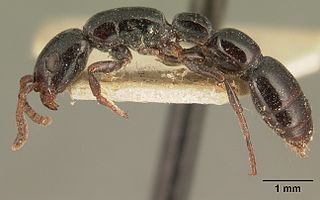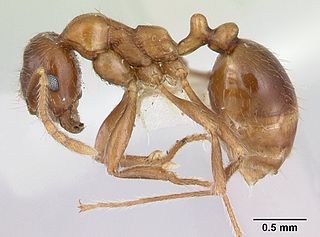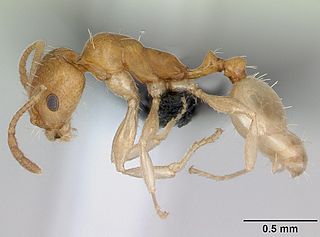
Myrmicinae is a subfamily of ants, with about 140 extant genera; their distribution is cosmopolitan. The pupae lack cocoons. Some species retain a functional sting. The petioles of Myrmicinae consist of two nodes. The nests are permanent and in soil, rotting wood, under stones, or in trees.

Monomorium is a genus of ants in the subfamily Myrmicinae. As of 2013 it contains about 396 species. It is distributed around the world, with many species native to the Old World tropics. It is considered to be "one of the more important groups of ants," considering its widespread distribution, its diversity, and its variety of morphological and biological characteristics. It also includes several familiar pest species, such as the pharaoh ant and the flower ant.

Crematogastrini is a tribe of myrmicine ants with 64 genera and 8 fossil genera.

Diaphoromyrma is a genus of ants in the subfamily Myrmicinae. It contains the single species Diaphoromyrma sofiae, known only from workers from the type locality in Bahia, Brazil. The genus is apparently close to Allomerus and Diplomorium in the Solenopsidini, but its tribal attribution remains uncertain.

Agroecomyrmecinae is a subfamily of ants containing two extant and two fossil genera. The subfamily was originally classified in 1930 by Carpenter as Agroecomyrmecini, a Myrmicinae tribe. Bolton raised the tribe to subfamily status in 2003, suggesting that Agroecomyrmecinae might be the sister taxon to Myrmicinae. It has since been discovered to be one of the earliest lineages of ants, a clade from the basal polytomy for all ants. In 2014, the subfamily was expanded to two tribes. The tribe Ankylomyrmini was moved from the subfamily Myrmicinae to Agroemyrmecinae.

Tatuidris, or armadillo ant, is a rare genus of ants consisting of a single species, Tatuidris tatusia. The ants are small in size and inhabit the leaf litter of Neotropical forests in Central and South America, from Mexico to Brazil. Workers are ferruginous-colored to dark red and present a distinctive morphology, consisting of a shield-like head with a broad vertex, ventrally-turned heavy mandibles which do not overlap at full closure, and unique among ants – an antenna socket apparatus sitting upside-down. Little is known about the biology of the ants, but they are likely nocturnal and specialist predators.

Simopone is a genus of predominantly arboreal ants in the subfamily Dorylinae. The genus is widely distributed in the Old World tropics, with the majority of species in Madagascar and sub-Saharan Africa.

Blepharidatta is a rare Neotropical genus of ants in the subfamily Myrmicinae. The genus, formed by predatory species whose small colonies nest in soil or leaf-litter, has up to seven species, but most of them are waiting for a formal taxonomic treatment or confirmation.

Lordomyrma is a genus of ants in the subfamily Myrmicinae.

Proatta is a Southeast Asian genus of ants in the subfamily Myrmicinae. It contains the single species Proatta butteli, known from the Malay Peninsula, Borneo and Sumatra.

Ankylomyrma is a genus of large arboreal ants in the subfamily Agroecomyrmecinae. It contains the single species Ankylomyrma coronacantha, the sole member of the tribe Ankylomyrmini. The genus is known from Africa. Nothing is known about their biology. The genus was moved from the subfamily Myrmicinae to Agroecomyrmecinae in 2014.

Meranoplus is an Old World genus of ants in the subfamily Myrmicinae. With over 80 valid species, it is predicted that over half of the Meranoplus diversity remains undescribed, most of these from Australia.

Tyrannomyrmex is a rare tropical genus of ants in the subfamily Myrmicinae. Three similar species, only known from workers, are recognized and share small eyes and edentate mandibles.

Kartidris is an Indomalayan genus of terrestrial ants in the subfamily Myrmicinae. Its six species are known from mountainous areas in China, Thailand and India.

Myrmisaraka is a Malagasy genus of ants in the subfamily Myrmicinae. Described in 2014, the genus contains two species.
Malagidris is a Malagasy genus of ants in the subfamily Myrmicinae. Described in 2014, the genus contains six species.

Vitsika is a Malagasy genus of ants in the subfamily Myrmicinae. Described in 2014, the genus contains 14 species.

Royidris is a Malagasy genus of ants in the subfamily Myrmicinae. Described in 2014, the genus contains 15 species endemic to Madagascar.

Trichomyrmex is a genus of ants in the subfamily Myrmicinae. Described by Mayr in 1865, it was raised as a genus in 2015. These ants are endemic to multiple continents.


















